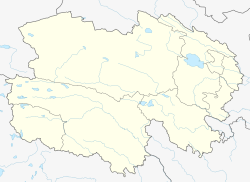| Reshui Township | |
|---|---|
| Township | |
| 热水乡 | |
 | |
| Coordinates: 36°13′15″N 98°09′47″E / 36.22083°N 98.16306°E / 36.22083; 98.16306 | |
| Country | China |
| Province | Qinghai |
| Prefecture | Haixi Prefecture |
| County | Dulan County |
| Area | |
| • Total | 90 km (30 sq mi) |
| Elevation | 3,293 m (10,804 ft) |
| Population | |
| • Total | 52,000 |
| • Density | 580/km (1,500/sq mi) |
| Time zone | UTC+8 (China Standard) |
| Postal code | 632822200 |
Reshui Township (simplified Chinese: 热水乡; traditional Chinese: 熱水鄉; pinyin: Rèshuǐ Xiāng) is a township in Dulan County, Haixi Mongol and Tibetan Autonomous Prefecture, Qinghai, western China. It is located at the base of the Jingpeng Pass at approximately 3,300 metres (10,800 ft) altitude on the Tibetan Plateau. The name of the township literally means "hot water", which may refer to the hot springs in the area.
Reshui is located on the 943 km long Jitong Railway, which was officially connected to the National network and became fully operative on 12 January 1995. The railway runs from Benhong (0 km)to Zhelimu (943 km). Reshui Town is close to Galadesitai railway station, located 517 km from the railhead at Benhong. This railway was operated by QJ steam engines operating in tandem until Autumn 2005 at which point it was dieselised. The railway has many spectacular features, particularly viaducts.
Reshui has been undergoing a development phase since 2004, with many new buildings and a new road bypass.
There are several raided burial tombs in a necropolis in Reshui.
The Kangxi Emperor of the Qing Dynasty said the water from Reshui was " holy water as precious as golden spring". Kangxi used to take hot water baths in Reshui after battles. Other emperors have also enjoyed the hot waters of Reshui.
Notes
- Archeology of Funeral Rituals as revealed by Tibetan tombs of the 8th to 9th century, Amy Heller, Ērān ud Anērān Webfestschrift Marshak 2003
External links
- View of Jitong steam locomotive in Reshui valley, with a goatherd carrying a load of dung on his back in the foreground
- video of people playing pool outside alongside a street in Reshui